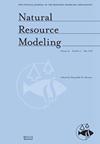Object‐based image analysis (OBIA)‐based gully erosion dynamics, sediment loading rate and sediment yield study in Lake Hawassa Sub‐basin, Ethiopia
IF 2.1
4区 环境科学与生态学
Q3 ENVIRONMENTAL SCIENCES
引用次数: 1
Abstract
Gully erosion is a serious environmental issue in Lake Hawassa Sub‐basin. It has affected a large portion of the catchment, and a large amount of sediment has been transported into the lake. This condition needs to be addressed. However, before conservation techniques are implemented, the gully systems should be mapped, their extent and changes over time need to be measured, and their capacity to produce sediment from their catchments should be determined. The objective of this study were, therefore, to map and analyse the change in gully erosion and quantify the sediment loading rate and sediment yield from the active and connected gullies in Lake Hawassa Sub‐basin using object‐based image analysis (OBIA) with high‐resolution SPOT 5 satellite image of the years 2011 and 2020. This method was integrated with field observation for mapping gully features of the study area, in comparison with automatic digitization carried out with the help of eCogenition Developer Version 9.1 and ArcGIS tools. Overall accuracy and Kappa coefficient were determined and were found to be 85.2% and 0.81, respectively, for the image of year 2020 and 81.1% and 0.76, respectively, for the image of year 2011. Based on the OBIA method, the extent of gullies (in area) were found to be 63.5 km2 in 2011 and 79.9 km2 showing a rapid increase between 2011 and 2020 (an increase of 16.4 km2 (24.4%) in the 10 years considered). The later result shows that 5.53% of the area of the Lake Hawassa Sub‐basin is affected by gully erosion. The maximum gully density in the study area was found to be 589 km/km2 in 2011 and this increased to 884 km/km2 in 2020. The sediment loading rate from the Lake's catchment was found to be in the range of 12.62 to 38.59 ton per hectare per year. The sediment yield from the Lake's catchment was 8.83 to 27.02 t/ha/year. The total annual volume‐based sediment yield at the Lake generated from the gully was 2.39 million cubic meter considering sediment delivery ratio of 70% for fully connected gullies. This result shows that 0.21% of the storage capacity of the Lake was being lost due to sedimentation from the gully system every year. From the result by dividing the total volume of the sediment by the surface area of the lake, one can see that a silt thickness of 2.51 cm was being deposited in the Lake every year.基于对象图像分析(OBIA)的埃塞俄比亚哈瓦萨湖次流域冲沟侵蚀动力学、输沙率和产沙量研究
在哈瓦萨湖次流域,冲沟侵蚀是一个严重的环境问题。它影响了大部分集水区,大量沉积物被运入湖中。这种情况需要解决。然而,在实施保护技术之前,应绘制冲沟系统的地图,测量其范围和随时间的变化,并确定其从集水区产生沉积物的能力。因此,本研究的目的是绘制和分析冲沟侵蚀的变化,并使用基于对象的图像分析(OBIA)和2011年和2020年的高分辨率SPOT 5卫星图像量化哈瓦萨湖次流域活动和连通冲沟的输沙率和产沙量。该方法与现场观测相结合,用于绘制研究区域的冲沟特征,并与借助eCogention Developer 9.1版和ArcGIS工具进行的自动数字化进行了比较。确定了2020年图像的总体准确度和Kappa系数,分别为85.2%和0.81,2011年图像的整体准确度和卡帕系数分别为81.1%和0.76。根据OBIA方法,发现(区域内)冲沟的范围为63.5 2011年为79.9平方公里 2011年至2020年间,面积迅速增加(增加16.4平方公里 km2(24.4%)。后来的结果表明,哈瓦萨湖次流域5.53%的面积受到冲沟侵蚀的影响。研究区域的最大冲沟密度为589 2011年增加到884 公里/平方公里。湖泊集水区的含沙量在12.62至38.59之间 吨/公顷/年。湖泊集水区的产沙量为8.83至27.02 t/ha/年。考虑到完全连接的冲沟的输沙率为70%,冲沟产生的湖泊年总体积产沙量为239万立方米。这一结果表明,每年有0.21%的湖泊库容因冲沟系统的沉积而丧失。根据沉积物总量除以湖面面积的结果,可以看出淤泥厚度为2.51 每年都有厘米的沉积物沉积在湖中。
本文章由计算机程序翻译,如有差异,请以英文原文为准。
求助全文
约1分钟内获得全文
求助全文
来源期刊

Natural Resource Modeling
环境科学-环境科学
CiteScore
3.50
自引率
6.20%
发文量
28
审稿时长
>36 weeks
期刊介绍:
Natural Resource Modeling is an international journal devoted to mathematical modeling of natural resource systems. It reflects the conceptual and methodological core that is common to model building throughout disciplines including such fields as forestry, fisheries, economics and ecology. This core draws upon the analytical and methodological apparatus of mathematics, statistics, and scientific computing.
 求助内容:
求助内容: 应助结果提醒方式:
应助结果提醒方式:


